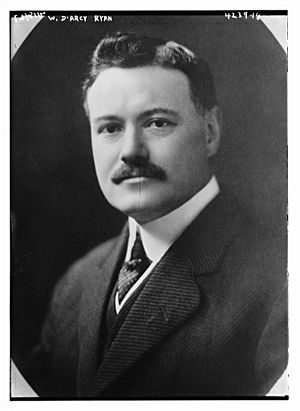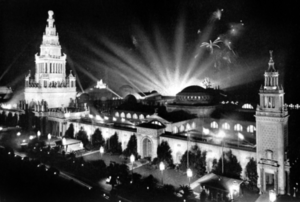Walter D'Arcy Ryan facts for kids
Quick facts for kids
Walter D'Arcy Ryan
|
|
|---|---|

Ryan in 1917
|
|
| Born | April 17, 1870 Kentville, Nova Scotia, Canada
|
| Died | March 14, 1934 (aged 63) |
| Employer | Lighting engineer |
| Organization | General Electric |

Walter D'Arcy Ryan (born April 17, 1870, in Kentville, Nova Scotia, Canada – died March 14, 1934, in Schenectady, New York, US) was a super important lighting engineer. He worked for General Electric and led their Illuminating Engineering Laboratory.
Ryan was a pioneer in lighting up tall buildings. He also created amazing light shows using colored searchlights, called the Scintillator. He was in charge of the lighting for huge events like the Panama–Pacific International Exposition in San Francisco and the Century of Progress Exposition in Chicago. He even lit up Niagara Falls completely for the first time! Ryan showed everyone how lighting could be both a science and a beautiful art form.
Contents
Early Life and His Big Ideas
Ryan was born in Kentville, Nova Scotia. He was supposed to have a military career, but he moved to the United States around 1890 instead. He started working for General Electric in Lynn, Massachusetts.
He quickly got promoted and became the head of the Commercial Department. This department later became the Illuminating Engineering Laboratory around 1908. This was the world's first place dedicated to researching lighting! Ryan and his team invented many new lighting technologies. They even patented a special car headlamp called the Ryan-Lite.
Lighting Up City Streets
Under Ryan's leadership, his lab also created a fancy streetlighting system. It was called the "White Way" because it was inspired by Broadway in New York City. General Electric helped towns and cities install these lights.
The very first "White Way" was put on Broadway Avenue in Los Angeles in 1905. Ryan said these lights helped create a "cosmopolitan atmosphere" and looked very "dignified."
Making Light a Spectacle
In 1908, Ryan and Charles G. Armstrong did something amazing. They were the first to light up an entire skyscraper! They used arc searchlights to light the Singer Building in New York City from its base up to the 35th floor. The very top of the tower was outlined with 1,600 light bulbs.
This lighting was planned when the building was designed. It was bright enough to see colors, but it wasn't perfect. Later, Ryan lit up other skyscrapers. In 1912, he lit the General Electric Company Building in Buffalo, New York. He used arc searchlights and a spinning searchlight on top that changed colors. This was a preview of the colored floodlighting he would do for big events.
Lighting Up New York City
Ryan was also in charge of lighting for the Hudson–Fulton Celebration in New York in 1909. For this event, he lit up all the main buildings, bridges over the East River, public spaces, and parts of Manhattan's coastline. He put colored searchlights on the Singer Building again.
People said the Singer Building tower could be seen from 40 miles away! It made a huge impression. One person wrote that everyone stopped to look at the Singer Building tower. It "glowed against the sky."
The Scintillator Light Show
Ryan also used searchlights for amazing light shows, which he called the Scintillator. Sometimes it was called the Ryan Scintillator. This show used searchlights with color filters. The light beams shone through steam, making different shapes. These shapes included a peacock's tail and a sunrise.
The Scintillator was a hit at the Hudson-Fulton Celebration. Shows happened twice every night at Riverside Drive. People described "Forty huge searchlights of varying color" shooting "enormous beams high in the air." They changed from bright white to soft greens and yellows. To create the steam, a large boiler was used, along with smoke bombs.
Niagara Falls Glows
In 1907, Ryan used 44 searchlights with colored filters to light up all of Niagara Falls for the very first time. This was a type of Scintillator show. For 30 nights in a row, the Falls glowed with color. The New York Tribune reported that the "whole great stretch of the Falls was a mass of color." The water below looked like "a pool of flame."
Lighting Up World's Fairs
In 1915, Ryan was the lighting designer for the Panama–Pacific International Exposition in San Francisco. This fair was the first to widely use floodlighting. It also used new types of lamps, like high-pressure gas lamps and powerful tungsten lamps.
Before this, fairs used strings of light bulbs. Ryan used floodlights for the main areas. He also used screens and filters to control the light. The fair buildings were arranged around courtyards. Each courtyard had a different color theme, even for the guards' uniforms! Ryan floodlit the buildings at night, making the light brighter higher up the towers.
The Tower of Jewels
The most amazing part of the fair was the Tower of Jewels. It was 435 feet tall and covered with 102,000 sparkling glass prisms. These prisms caught the sunlight during the day. At night, they reflected 54 searchlight beams, making the tower shine!
Ryan carefully hid the floodlights and red bulbs so there were no harsh shadows. He also slowly turned on the lights at dusk, instead of just flipping a switch. The lighting was meant to be beautiful and cozy. Three times a week, Scintillator shows created amazing effects in the sky. Ryan himself wrote that "Soft radiant energy is everywhere." He wanted to create a magical atmosphere.
This new floodlighting was cheaper to install and run than old methods. It allowed for artistic effects with shimmering light and contrasts. This fair set the standard for how future fairs would be lit.
Chicago's Century of Progress
Almost 20 years later, in 1933, Ryan designed the lighting for Chicago's Century of Progress Exposition. This fair was also famous for its new lighting ideas. To match the modern "art moderne" buildings, Ryan used new electric lamps called gaseous discharge lamps, especially neon. There were over 75,000 feet of neon tubing!
The fair was planned as a huge light show. The buildings were bright, smooth, and shiny to reflect light well. The fair even opened at night with fireworks! The fireworks were set off by light from the star Arcturus. This light was turned into an electrical pulse.
The outside lighting needed a lot of power. The General Electric building had a fake waterfall on its side that used 5,000 feet of blue tube lighting! Ryan used new technology to get the most light for the fair's budget. Scintillators were used again with smoke effects. The largest light bulb in the world, a 50-kilowatt lamp, was on display.
For its second year in 1934, the lighting was made even brighter. The Ford Building had a "Pillar of Light" made by 24 searchlights shining a mile into the sky. The fair's closing event was called "The Festival of Illumination." This fair also influenced how future fairs were lit.
Later Life
In June 1932, Walter D'Arcy Ryan became a special consulting engineer for General Electric. He passed away on March 14, 1934, after a heart attack.

